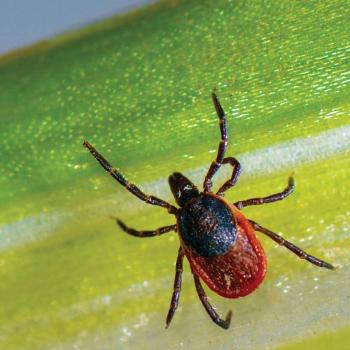UMaine Extension’s Tick Lab releases research showing elevated activity in Midcoast counties
University of Maine Cooperative Extension Tick Lab recently published a research report in the Journal of Maine Medical Center highlighting trends in tick species distribution and the pathogens associated with each type. Notably, the epicenter of activity in Maine is clustered in Midcoast Maine — Hancock, Knox, Lincoln and Waldo counties — where submission rates are high and the prevalence of pathogens is elevated.
“Passive Tick Surveillance at the University of Maine Cooperative Extension Tick Lab: A 6-Year Retrospective” confirms the important role the black-legged tick (Ixodes scapularis) plays in Maine’s tick-borne disease landscape and emphasizes the need for surveillance of emerging species and pathogens, including those that cause Lyme disease, anaplasmosis, babesiosis, Rocky Mountain spotted fever, ehrlichiosis and Powassan virus.
The comprehensive database of ticks used for the study is compiled from samples submitted by members of the public located across the state. Researchers then used the data to determine trends in the distribution of tick species and related pathogens.
“The lab’s passive tick surveillance program can effectively detect the establishment of ticks in new areas, indicate changes in pathogen prevalence and show fluctuations in seasonality,” said Griffin Dill, coordinator of the Tick Lab. “This data is important in determining public health risks and can be used to guide targeted intervention strategies, education campaigns and proactive measures to manage ticks. Taken with other surveillance efforts, the findings can provide deeper insight into drivers of tick ecology and human exposure risk.”
Over the six years of the study, the lab received more than 22,000 tick specimens for testing from all 16 of Maine’s counties and from 466 municipalities, reflecting strong public engagement in the program and a growing awareness of ticks and tick-borne disease risks. Although multiple species were submitted, the black-legged tick — a vector for Lyme and other serious tick-borne diseases — was a dominant and broadly distributed species across the state.
The highest number of samples was received from Cumberland County. However, when accounting for the population size of each county, the annual submission rates per 100,000 residents were the greatest from Hancock, Lincoln, Knox and Waldo counties. Ecologically, this coastal region maintains diverse habitats, abundant wildlife host species and increasingly mild winters, all of which can favor tick survival and pathogen transmission. These same counties also report some of the highest human incidence rates of Lyme disease, anaplasmosis and babesiosis.
While black-legged ticks and the bacteria that causes Lyme disease remain common, increases in other species and pathogens reinforces the need for continued surveillance and additional testing for less common tick-borne pathogens.
Funding for ongoing UMaine research on ticks and tick-borne pathogens is supported by nearly $6.2 million in Congressionally Directed Spending secured by U.S. Sen. Susan Collins, currently chair of the Senate Appropriations Committee. Additionally, an annual state appropriation directly supports the operations of the tick lab and enables UMaine to maintain testing affordability for Maine residents.
Maine residents can submit ticks for identification and testing by completing the online submission form at ticks.umaine.edu and mailing the sample to UMaine Extension Tick Lab, 17 Godfrey Drive. Identification is free; pathogen testing is $20 per tick. The website also provides information on how to protect yourself and your pets and how to manage your property to reduce your risk of tick encounters.
About University of Maine Cooperative Extension
As a trusted resource for over 100 years, Extension has supported UMaine's land and sea grant public education role by conducting community-driven, research-based programs in every Maine county. UMaine Extension seeks to build thriving communities and grow the food-based economy, focusing on aspects from production and processing to nutrition, food safety and food security. Extension also conducts the most successful out-of-school youth educational program in Maine through 4-H which offers hands-on projects in areas like health, science, agriculture and civic engagement and creates a positive environment where participants are encouraged to take on proactive leadership roles.
About the University of Maine
As Maine’s only public research university and a Carnegie R1 top-tier research institution, the University of Maine advances learning and discovery through excellence and innovation. Founded in 1865 in Orono, UMaine is the state’s land, sea and space grant university with a regional campus at the University of Maine at Machias. Our students come from all over the world and work with faculty conducting fieldwork around the globe — from the North Atlantic to the Antarctic. Located on Marsh Island in the homeland of the Penobscot Nation with UMaine Machias located in the homeland of the Passamaquoddy Nation, UMaine’s statewide mission is to foster an environment that creates tomorrow’s leaders. As the state’s flagship institution, UMaine offers nearly 200 degree programs through which students can earn bachelor’s, master’s, professional master’s and doctoral degrees as well as graduate certificates. For more information about UMaine and UMaine Machias, visit umaine.edu/about/quick-facts/ and machias.edu/about-umm/umm-facts/.
































